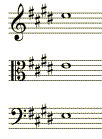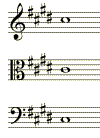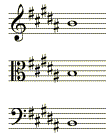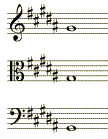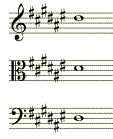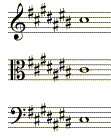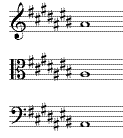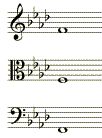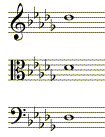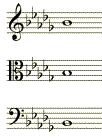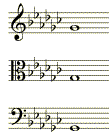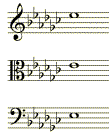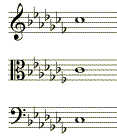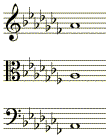|
The Natural Minor Scale
::

|
Key words:
natural minor scale
ancient minor scale |
| 1 |
The Natural Minor Scale
In lesson 8 we first met the major scale. We are now going to look at another scale that is important in Western music. It is called the natural minor scale or ancient minor scale. We have marked the notes A in pink on the keyboard below and our first natural minor scale is going to begin on A. Starting from the key marked A below middle C (that is, the key C with an asterisk), play the naturals (the white keys) in ascending order, A, B, C, D, E, F, G and finish on the A above middle C. This sequence or row of eight notes is the A natural minor scale, the natural minor scale in which the key-note is A. Music written using the notes of this scale is said to be 'in the key of A minor'. As in major scales, each note must bear a different 'letter' name and the different notes are called the degrees of the scale. The key note is called the 'first degree of the scale', B is the 'second degree of the scale', and so on. What makes this a natural minor scale is the distinctive sequence of tones (whole steps) and semitones (half steps). If we write down the intervals between the notes rather than the key names then the A minor scale is tone-semitone-tone-tone-semitone-tone-tone, seven intervals between eight notes. In 'whole step-half step' notation the interval sequence is written whole step - half step - whole step - whole step - half step - whole step - whole step. If you play any other ascending row of eight consecutive naturals you will find many different sequences of intervals but A minor is the only natural minor scale using only the white keys. We illustrate this scale below. 
|
|
|
Chart of the Natural Minor Scales
::

|
Key word:
chart of natural minor scales |
| 1 |
Chart of the Natural Minor Scales
|
|
|
Double Sharps & Flats
::

|
Key words:
double sharp
double flat |
| 1 |
Double Sharps & Flats
When discussing the pattern of intervals characteristic to major scales we noted that each note of the scale must have a different 'letter' name. In minor scales the same convention must be observed. However, with minor scales we will have to incorporate the additional concept of scale modification by 'raising' or 'lowering' notes. Musicians like to preserve the sense of 'key' in the notation and so, when a note already sharpened by the key signature is to be 'raised' or sharpened further, we use the double sharp sign  . . In a similar way, a 'flat' note 'lowered' further, is marked with a double flat sign  . . A double sharp, or double flat, raises, or lowers, the pitch of the note a full tone above the note with no accidental. So, F double sharp is enharmonic to G natural. Both signs follow the standard rules for accidentals. These signs will be considered further when we discuss intervals in lesson 12.
|
|
|
Harmonic Minor
::

|
Key words:
harmonic minor scale
seventh degree
leading note
tonic
dominant chord
dominant 7th chord
tritone |
| 1 |
Harmonic Minor
To satisfy the harmonic requirements of music written in minor keys, in particular that they preserve some of the harmonic characteristics associated with major scales, our natural minor scale has to be modified. If you look at a major scale you will remember that the seventh degree, the leading note is only a semitone below the tonic. The term leading note is a good description of the way it works harmonically. The leading note draws or 'leads' you to the tonic above. It is an example of a tendency tone, a note that has a strong pull toward another. The reason for this will become clearer once we examine chords and cadences in a later lesson. Looking again at our minor scale you will see that the leading note is a tone below the tonic above it - this weakens its harmonic effect as a 'leading' note. The problem is overcome by sharpening the leading note, changing G to G sharp, so that the row is now A, B, C, D, E, F, G sharp, A and the interval sequence becomes tone-semitone-tone-tone-semitone-tone and a half-semitone.  This scale is called the harmonic minor and is the same ascending and descending. A question commonly asked is 'why is the harmonic minor scale so named?'. To understand chord names and numbering you may wish to preview lesson 16. If the dominant (V) is to lead back to the tonic (I), usually by using a dominant 7th, the dominant chord must be a major chord. The 'pull' from the dominant 7th comes from the tritone, (see lesson 12 - the tritone), that lies between the third and the seventh of the chord, and has the effect of 'unsettling' the chord. In the scale of A minor the dominant is E. The seventh chord on E is E-G-B-D which is an Em7 chord. The Em7 has a perfect fifth between G and D which effectively stabilizes the chord. To create the harmonically necessary tritone, the G has to be raised to G#. The seventh on E is now an E7 chord, E-G#-B-D, with the harmonically important tritone between G# and D. If you would like to hear a harmonic minor scale played we have included a score produced with the music publishing program Sibelius. To play the scale, press the play button below. You can hear other harmonic scales by 'transposing' the score using the transpose button above and we have included a chart of all the scales below. Note that the accidental (the sharp sign in front of the G) is shown in the melodic line and not placed in the key signature which remains that of the natural minor scale on the same key-note.
|
|
|
Chart of the Harmonic Minor Scales
::

|
Key word:
chart of harmonic minor scales |
| 1 |
Chart of the Harmonic Minor Scales
|
|
|
Melodic Minor
::

|
Key word:
melodic minor scale |
| 1 |
Melodic Minor
The modification leading to the harmonic minor scale produces one peculiar feature. The interval between the sixth and seventh degrees of the scale is now a tone and a half which is uncomfortably wide when writing melody. It would be better if we could widen the interval between the fifth and sixth degrees, from a semitone to a tone, and narrow the interval between the sixth and seventh degrees, to a tone. The row then becomes A, B, C, D, E, F sharp, G sharp, A and the interval sequence becomes tone-semitone-tone-tone-tone-tone-semitone. Did you notice that this is just the major scale on A, but with a flattened third (C sharp in the major scale, C natural in our new minor scale)?  What distinguishes the new melodic minor scale from the harmonic minor scale in the previous section is that the scale is not the same descending as it is ascending. When a melody moves down the scale, from the tonic to the leading note below it, it does not matter whether the interval is a tone or a semitone. This only matters when the melody moves up, from the leading note to the tonic. Indeed, the 'pull' from the flattened sixth to the dominant (the fifth) is of greater importance. The falling melodic minor scale in the key of A minor is the falling natural minor scale. The falling melodic minor scale is A, G, F, E, D, C, B, A.  If you would like to hear a melodic minor scale use the play button. You can hear other melodic scales by 'transposing' the score using the transpose button above. We have included a chart of the melodic minor scales below.
|
|
|
Chart of the Melodic Minor Scales
::

|
Key word:
chart of harmonic minor scales |
| 1 |
Chart of the Melodic Minor Scales
|
|
|
Relative & Parallel Major & Minor
::

|
Key words:
key note
key signature
relative major
parallel major
relative minor
parallel minor
rule of 7
rule of 12
key name
tonic major
tonic minor |
| 2 |
'Rule of 12'
The progression of increasing sharp keys has a standard upward 'shift' of a perfect fifth, i.e. seven semitones up. So G is a fifth above C and F sharp is a fifth above B natural. The progression of increasingly flat keys has a standard upward 'shift' of a perfect fourth. So from C to F is a fourth, as is the interval from D flat to G flat. The flat key shift, i.e. five semitones up, is actually the result of 'shifting' downwards a perfect fifth, i.e. seven semitones down. In the diatonic scale, a shift of 7 semitones down is 'complementary' to a shift of 5 semitones up, because both result in the same note class. Thus, F is a fourth above C and a fifth below C. As one might expect, the two shifts together total 12 semitones, the number of semitones in a perfect octave.
|
| 3 |
'Rule of 7'
If you take the keys with the same letter name and add the number of sharps and flats in the two key signatures, the result is always 7 (except for C flat and C sharp major where the number of sharps and flats totals 14). So for A major, 3 sharps, and A flat major, 4 flats, the total is 7. This is also true with the minor keys. This provides a welcome 'rule of thumb' when trying to remember the number of sharps or flats in the more sharp or flat key signatures.
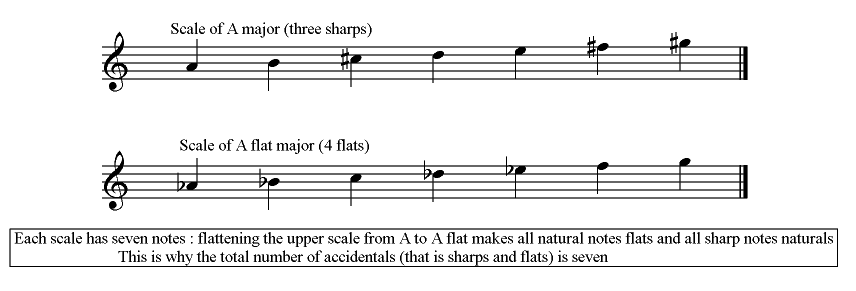
Comparing the key signatures of 'enharmonic' keys, for example D flat major and C sharp major one discovers that the total number of sharps and flats in the two key signatures equals 12. D flat major has 5 flats and C sharp major has 7 sharps. This is another useful 'rule' for calculating quickly the number of sharps or flats in a particular key. Remember that while key signatures do not contain more than 7 sharps or 7 flats, modulations from keys with this number of sharps and flats can lead to a temporary situtation where there are more than 7 flats or 7 sharps in operation. In these cases, double sharps or double flats may appear. Does the 'rule of 12' work for these more exotic keys, for example, G sharp major with 8 sharps, D sharp major with 9 sharps or F flat major with 8 flats? Noting that double sharps count as 2 sharps and double flats as 2 flats, we find that, for example, E flat major with 3 flats and D sharp major with 9 sharps, (E flat and D sharp are enharmonic), again gives a total of 12 sharps and flats.
|
| 4 |
Key Signatures & Key Names
When trying to remember the particular sharps or flats for major keys, observe that the key name for sharp keys is one semitone above the last added sharp.
Let us explain this statement in more detail.
As we progress from the key of C major, which has neither a sharp nor a flat in the scale, to the first of the 'sharp' keys, G major, you will notice that a sharp has been added to the seventh degree of the scale - that is, the seventh note is F sharp. The next 'sharp' key, D major, which has two sharps in the key signature, retains the F sharp, but now a new sharp is added to the seventh degree, which is C sharp. This pattern continues on up to the key of C sharp major, which has seven sharps, where the newly added sharp is B sharp. Remember that all the sharps added to the scale in the 'less sharp' keys are retained as further sharps are added, and particularly note that the order in which sharps are being added is preserved in the steadily extended key signature itself.
For the flat keys, the key name is the last but one added flat. Because the key of F has only one flat we must pass onto the key with two flats in the key signature to see how this recipe works. In B flat major, which has a key signature with two flats, in order B flat (which first appeared in the key of F major) and then E flat (which newly appears in the key of B flat major), the earlier one names the key.
This makes it easy to read the key of a piece of music from the way the sharps or flats are ordered, from left to right, in the key signature.
Be careful though that you are in a major key and not in a minor key!
|
| 5 |
Relative & Parallel Major & Minor
It is a 'convention' widely used to show the key-notes of minor keys as lower case, and those of major keys as upper case or capital, letters.
Because the key signatures for A flat major and f minor are identical, f minor is said to be the relative minor to A flat major and A flat major is said to be the relative major to f minor. However, this 'relationship' is specious. The real 'relatives' are the pairs of keys with the same key note - for example, A flat major and a flat minor. These are called parallel keys. The pair can also be termed tonic major and tonic minor to indicate the common tonic or key note. In baroque dance suites, dances may occur in pairs, i.e. two minuets or two gavottes, where one is written in the major key and the other is written in the minor key with the same key note. In such cases, the composer may ask the performer to repeat the first of the pair, placing the second between two performances of the first. Lesson 31 discusses how the score reader may be able to distinguish between the use of major and minor keys by examining the use of accidentals and particular chord forms.
|
|
 :: next lesson :: next lesson
| |
 :: next lesson
:: next lesson
 .
. .
.










